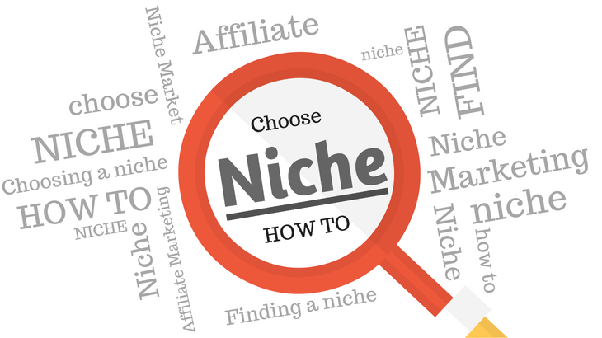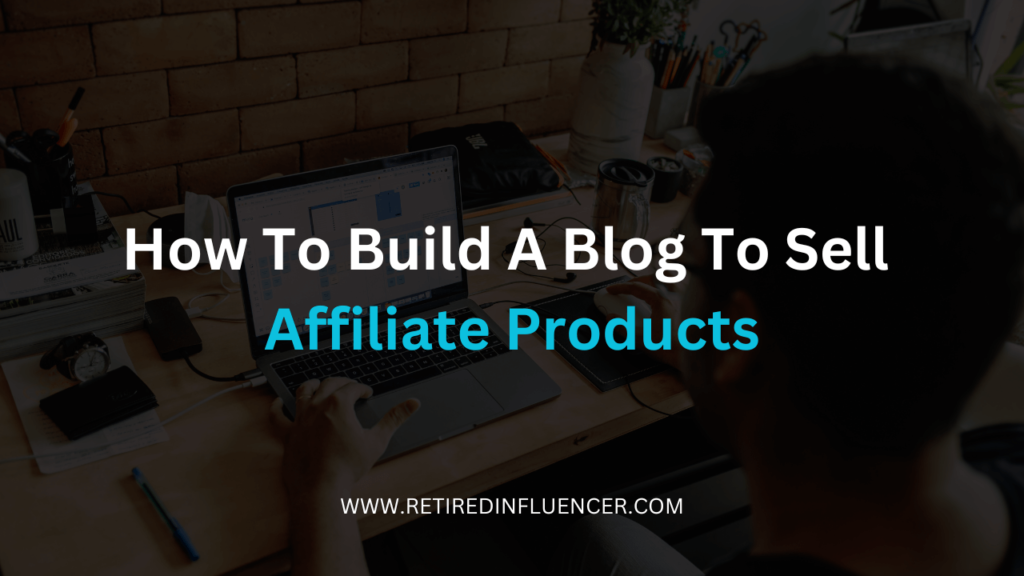Blogging is a fantastic way to make an extra or full-time income online. In this step-by-step guide, I’ll show how to build a blog to sell affiliate products.
You’ll learn how to pick the right niche, set up your blog, and create engaging content that attracts the right buyers to your affiliate offer.
If you truly want to make money online with affiliate marketing using a blog, follow these steps to start earning commission and build a profitable affiliate marketing business using a blog.
Table of Contents
What Is The Best Way To Build A Blog To Sell Affiliate Products?
- Decide On A Niche
- Choose A Blogging Platform
- Set Up Your Blog
- Research And Join Affiliate Programs
- Create High Quality Content
- Build Your Audience
- Monitor Your Performance
- Follow Ethical Practices
How Much Can You Earn With Affiliate Marketing Using A Blog?
The amount you can make with affiliate marketing through a blog varies widely and depends on several factors, including your niche, traffic volume, content quality, and marketing strategies.
Here’s a breakdown to give you an idea of the potential earnings at different stages.
Potential Earnings by Stage
1. Beginner Stage (0-6 Months):
- Earnings: $0 – $500 per month
- Description: During the initial months, you’re likely setting up your blog, creating content, and starting to attract some traffic. Earnings might be minimal as you build your foundation.
2. Growth Stage (6-12 Months):
- Earnings: $500 – $2,000 per month
- Description: As your traffic grows and you publish more quality content, you should start seeing more consistent earnings. This period involves refining your strategies and increasing your audience engagement.
3. Established Stage (1-2 Years):
- Earnings: $2,000 – $10,000 per month
- Description: With a well-established blog, substantial traffic, and properly optimized content, you can start earning a significant income. Many bloggers reach a full-time income level at this stage.
4. Expert Stage (2+ Years):
- Earnings: $10,000+ per month
- Description: At this stage, top bloggers with large audiences, subscribers, or followers and high-quality content can earn substantial amounts. Diversifying traffic sources and income streams and leveraging high-ticket affiliate programs can increase earnings.
Recommended Reading: How To Start A Blog Successfully
How To Build A Blog To Sell Affiliate Products Step-by-Step
Here is how to build a successful blog to sell affiliate products and start earning a decent commission on your sales.
Step 1: Decide On A Niche
Selecting the right niche is crucial for affiliate marketing success. A niche is a specific topic or market that you focus on.
I recommend you choose a topic that you’re interested in, passionate about, and know well and care about, and that also has a big audience with the potential to buy products or services.
How to Choose a Niche
- Follow Your Passion: Pick something you love. When you are passionate about a topic, creating content becomes easier and more enjoyable. Your enthusiasm will also resonate with your audience.
- Research Market Demand: Use tools like Google Trends and keyword research to find out if there is a high demand for your chosen niche. Look for a balance between popularity and competition.
- Identify Problems and Solutions: Choose a niche where you can solve problems for people. If your audience has specific needs or pain points, they are more likely to buy products that offer solutions.
- Consider Profitability: Research the earning potential of your niche. Look at the types of products available and their commission rates. High-ticket items or recurring commission products can be more profitable.
- Check the Competition: Analyze your competition to see what they are doing well and what gaps you can fill. A highly competitive niche can be challenging, so find your unique angle.

Mistakes to Avoid When Choosing a Niche
- Ignoring Your Interests: Don’t choose a niche just because it seems profitable. If you’re not interested in the topic, you’ll struggle to create engaging content and may lose motivation.
- Overlooking Market Research: Failing to research market demand can lead to targeting a niche with little to no audience interest. Ensure there is enough demand to sustain your efforts.
- Choosing Too Broad or Too Narrow a Niche: A niche that is too broad can be overwhelming and hard to rank for. A niche that is too narrow may not have enough audience to generate income. Find a balance.
Step 2: Choose A Blogging Platform
Selecting the right blogging platform is essential for your affiliate marketing journey. A good platform makes it easy to create, manage, and grow your blog.
WordPress is a popular choice because it is user-friendly, customizable, and has a large community for support.
Why Choose WordPress?
- User-Friendly: WordPress is easy to use, even for beginners. It has a simple interface that makes creating and publishing content straightforward.
- Highly Customizable: With thousands of themes and plugins, you can tailor your blog to fit your specific needs and style. This flexibility allows you to add features and design elements that enhance your site.
- Large Community: WordPress has a vast community of users and developers. This means you can find plenty of resources, tutorials, and forums to help you solve problems and improve your blog.
- SEO-Friendly: WordPress is built with SEO in mind, making it easier to optimize your content for search engines. There are also many plugins available to help boost your SEO efforts.
Tips for Choosing a Blogging Platform
- Ease of Use: Pick a platform that is easy to navigate and doesn’t require extensive technical skills. You want to spend more time creating content than figuring out how to use the platform.
- Customization Options: Ensure the platform offers a variety of themes and plugins to customize your blog’s appearance and functionality.
- SEO Features: Look for platforms that offer built-in SEO tools or support SEO plugins. Optimizing your content for search engines is crucial for driving traffic to your blog.
- Scalability: Select a platform that can grow with you. As your blog expands, you may need more features and capabilities. Make sure the platform can handle increased traffic and content.

Mistakes to Avoid When Choosing a Blogging Platform
- Choosing Based on Price Alone: A free platform might save money initially, but it can lack essential features and support. Consider the long-term benefits and costs.
- Ignoring Mobile Responsiveness: Ensure the platform you choose supports mobile-responsive themes. Many users access blogs via mobile devices, and a non-responsive site can hurt your traffic.
- Overlooking Security: Security is crucial for protecting your blog from hackers and malware. Choose a platform with robust security features and regular updates.
Step 3: Set Up Your Blog
Getting your blog up and running involves several important steps. You need to choose a domain name, select a hosting service, and install WordPress.
Then, customize your blog with a professional theme, header, and logo to make your blog look professional, attractive, and engaging.
How to Set Up Your Blog
- Choose a Domain Name: Your domain name is your blog’s address on the internet. It should be easy to remember, relevant to your niche, and preferably short. Try using keywords related to your niche to help with SEO.
- Select a Hosting Service: A good web hosting service ensures your blog is always accessible and runs smoothly. Popular choices include Bluehost, SiteGround, and HostGator. Look for reliable uptime, good customer support, and reasonable pricing.
- Install WordPress: Most hosting services offer a one-click WordPress installation. Follow the prompts from your hosting provider to install WordPress on your domain. This process is usually quick and straightforward.
- Choose a Professional Theme: A theme determines the look and feel of your blog. WordPress offers many free and premium themes. Pick one that looks professional, is mobile-responsive, and suits your niche. Customize it to match your brand’s colors and style.
- Create a Header and Logo: Your header and logo are the first things visitors see. A well-designed header and logo make your blog look professional and build brand recognition. You can use tools like Canva or hire a designer to create these elements.
Tips for Setting Up Your Blog
- Keep It Simple: Choose a clean and simple theme that is easy to navigate. Avoid cluttering your site with too many elements.
- Prioritize Speed: Fast-loading websites keep visitors engaged. Choose a hosting service and theme that prioritizes speed. Use plugins like WP Super Cache to enhance your site’s performance.
- Make It Mobile-Friendly: Ensure your theme is mobile-responsive. Many users will access your blog on their phones, so it should look good and function well on all devices.
- Optimize for SEO: Use SEO-friendly themes and install plugins like Yoast SEO to help optimize your content. This will improve your search engine rankings and drive more traffic to your blog.
- Add Essential Plugins: Install plugins to enhance your blog’s functionality. Popular ones include Akismet for spam protection, Jetpack for site performance, and Contact Form 7 for creating contact forms.
Mistakes to Avoid When Setting Up Your Blog
- Choosing a Complicated Domain Name: A complex or hard-to-spell domain name can make it difficult for people to find your blog. Please keep it simple and memorable.
- Skipping Backup and Security Measures: Regular backups and security plugins are essential to protect your blog from data loss and cyber-attacks. Don’t overlook these crucial steps.
- Using Too Many Plugins: Too many plugins can slow down your site and cause conflicts. Use only the necessary plugins and keep them updated.
- Neglecting User Experience: Your blog should be easy to navigate. A confusing layout can drive visitors away. Test your site’s usability and make improvements as needed.
- Ignoring Legal Requirements: Ensure your blog complies with legal requirements like privacy policies and disclaimers. This protects you and builds trust with your audience.
Step 4: Research And Join Affiliate Programs
Joining affiliate programs is a key step in monetizing your blog. Affiliate programs allow you to earn commissions (money) by promoting products and services related to your niche.
Research and choose programs that align with your blog’s content and target audience interest.
How to Join Affiliate Programs
1. Research Relevant Programs: Look for affiliate programs that offer products or services related to your niche. For example, if your blog is about tech, programs like Amazon Associates or Newegg’s affiliate program might be a good fit.
2. Evaluate Commission Structures: Different programs offer various commission rates and payment structures. Compare these to find programs that offer good earning potential. Some might offer a percentage of each sale, while others provide a flat fee.
3. Check Program Reputation: Choose programs with a good reputation. Read reviews and feedback from other affiliates to ensure the program is trustworthy and pays on time.
Tips for Joining Affiliate Programs
Choose Quality Over Quantity: Focus on joining a few high-quality affiliate programs rather than spreading yourself too thin. Quality programs will offer better support and higher conversion rates.
Look for Programs with Good Support: Programs that offer excellent support and resources can help you succeed. They might provide training, marketing materials, and insights to improve your affiliate efforts.

Mistakes to Avoid When Joining Affiliate Programs
Joining Too Many Programs: Signing up for too many programs can be overwhelming and dilute your focus. Start with a few and expand as you become more comfortable.
Promoting Irrelevant Products: Avoid promoting products that don’t fit your niche or audience. Irrelevant promotions can reduce trust and engagement with your readers.
Ignoring Program Terms: Read and understand the terms and conditions of each affiliate program. Failure to comply can result in loss of commissions or even being banned from the program.
Step 5: Create High Quality And Relevant Content
Creating high-quality content that’s related to your niche is essential for attracting and retaining readers while effectively promoting affiliate products.
Your blog posts should be helpful, informative, engaging, and well-optimized for search engines to drive traffic and increase conversions.
How to Create Quality Content For Your Blog
- Focus on Value. Write blog posts that provide real value to your readers. Address their problems, answer their questions, and offer useful insights related to your niche. High-quality content will keep readers coming back for more.
- Engage Your Audience. Make your posts interesting and engaging. Use a conversational tone, incorporate storytelling, and include visuals like images and videos to make your content more appealing.
- Incorporate Affiliate Links Naturally. When mentioning products or services, include affiliate links in a way that feels natural and helpful. Avoid overloading your posts with links; instead, focus on providing genuine recommendations.
- Optimize for SEO. Use relevant keywords throughout your content to improve search engine rankings. Optimize your titles, headings, and meta descriptions. Include internal and external links to enhance your content’s credibility and authority.
- Write Clear and Concise Content. Ensure your writing is easy to read and understand. Break up text with subheadings, bullet points, and short paragraphs to make your posts more digestible.
Tips for Creating Quality Content For Your Affiliate Blog
Conduct Thorough Research: Base your content on thorough research to ensure accuracy and relevance. Use reputable sources and provide evidence to back up your claims.
Use Catchy Headlines: Craft compelling headlines that grab attention and encourage clicks. A good headline should be clear, concise, and include your main keyword.
Incorporate Visuals: Add images, infographics, and videos to complement your text. Visuals can help illustrate points, make your posts more engaging, and break up large blocks of text.
Encourage Interaction: Include calls-to-action (CTAs) that encourage readers to leave comments, share your posts, or sign up for your newsletter. Engaging with your audience can boost loyalty and interaction.
Update Content Regularly: Keep your content fresh and relevant by updating old posts and adding new information. Regular updates can improve your SEO and keep your audience engaged.

Mistakes to Avoid When Creating Content For Your Blog
Overloading with Affiliate Links: Don’t make your posts feel like a sales pitch. Too many affiliate links can come off as spammy and reduce trust. Integrate them thoughtfully and sparingly.
Neglecting SEO Best Practices: Failing to optimize your content for search engines can limit your visibility. Make sure to use relevant keywords and follow SEO guidelines to enhance your rankings.
Ignoring Reader Needs: Don’t create content solely based on what you want to promote. Focus on what your readers are interested in and what problems they need solutions for.
Overlooking Proofreading: Typos and grammatical errors can undermine your credibility. Always proofread your content or use tools to check for errors before publishing.
Neglecting Mobile Optimization: Ensure your content is easy to read on mobile devices. Many users access blogs via smartphones, so your content should be mobile-friendly and responsive.
Step 6: Build Your Audience
Building an audience is crucial for the success of your affiliate marketing blog. A larger, engaged audience means more traffic, which can lead to higher affiliate sales.
Promote your blog on social media, engage with your followers, and consistently offer valuable content to attract new readers.
How to Build Your Audience
- Promote on Social Media: Share your blog posts on popular social media platforms like Facebook, Twitter, Instagram, and LinkedIn. Each platform has its own strengths, so tailor your content to fit the style and audience of each one.
- Engage with Followers: Respond to comments and messages on your blog and social media. Engaging with your audience builds a community and encourages repeat visits. Show appreciation for their input and foster conversations around your content.
- Offer Valuable Content: Consistently provide content that solves problems, answers questions, or entertains your audience. High-quality, valuable content will attract new readers and keep existing ones coming back.
- Collaborate with Influencers: Partner with influencers in your niche to reach a broader audience. Influencers can help promote your blog to their followers, increasing your visibility and credibility.
- Use Email Marketing: Build an email list by offering incentives like free guides, e-books, or exclusive content. Regularly send newsletters with updates, new blog posts, and special offers to keep your audience engaged.
Tips for Building Your Audience
Create Shareable Content: Write posts that are informative, entertaining, or inspiring. Include share buttons to make it easy for readers to share your content with their networks.
Host Webinars and Live Sessions: Live interactions such as webinars or Q&A sessions can engage your audience in real-time and provide valuable insights. Promote these events on your blog and social media to draw in viewers.
Guest Posting: Write guest posts for other blogs in your niche. This exposes your content to a new audience and can drive traffic back to your own blog.
Step 7: Monitor Your Performance
Monitoring your blog’s performance is crucial for understanding what works and what doesn’t.
By tracking your website’s traffic and conversion rates using tools like Google Analytics, you can make informed adjustments to improve your results and maximize your affiliate marketing efforts.
How to Monitor Your Performance
Set Up Google Analytics: Install Google Analytics on your blog to start tracking important metrics. This free tool provides comprehensive data on your website’s traffic, user behavior, and conversions.
Track Key Metrics: Focus on metrics that matter most to your blog’s success. These include:
Traffic Sources: Understand where your visitors are coming from (e.g., search engines, social media, direct visits).
- Page Views: Monitor the number of views each page receives to identify popular content.
- Bounce Rate: Track the percentage of visitors who leave your site after viewing only one page. A high bounce rate can indicate that your content isn’t engaging enough.
- Average Session Duration: Measure how long visitors stay on your site. Longer sessions suggest that your content is engaging and valuable.
- Conversion Rates: Track the percentage of visitors who take a desired action, such as clicking on an affiliate link or making a purchase.
- Set Goals: Define specific goals in Google Analytics to measure your success. For example, you can set goals for the number of affiliate link clicks or newsletter sign-ups.
Analyze User Behavior: Use behavior flow reports to see how visitors navigate your site. This helps you understand the typical paths users take and identify any bottlenecks or drop-off points.
Tips for Improving Your Performance
Optimize High-Traffic Pages: Focus on improving the pages that receive the most traffic. Ensure these pages have clear calls-to-action and are optimized for conversions.
A/B Testing: Conduct A/B tests to compare different versions of your content or design elements. This helps you determine which variations perform better and refine your approach.
Improve Load Times: Slow-loading pages can frustrate visitors and increase bounce rates. Use tools like Google PageSpeed Insights to identify and fix issues that affect your site’s speed.
Mistakes to Avoid When Monitoring Performance
Ignoring Data: Failing to regularly check and analyze your analytics data can result in missed opportunities for improvement. Make data-driven decisions to enhance your blog’s performance.
Step 8: Follow Ethical Practices
Following ethical practices is essential for building trust with your audience and maintaining credibility as an affiliate marketer.
Always disclose your affiliate relationships in your posts and promote products that you genuinely believe in and that are relevant to your audience.
How to Follow Ethical Practices
Disclose Affiliate Relationships: Always be transparent about your affiliate relationships. Let your readers know when a post contains affiliate links. This builds trust and complies with legal requirements, such as the Federal Trade Commission (FTC) guidelines.
Promote Products You Believe In: Only promote products and services that you have used or thoroughly researched and truly believe in. Your recommendations should be genuine and reflect your honest opinions.
Ensure Relevance: Make sure the products you promote are relevant to your niche and audience. Irrelevant promotions can alienate your readers and damage your credibility.
Provide Honest Reviews: When reviewing products, be honest about their pros and cons. Providing balanced reviews helps your audience make informed decisions and reinforces your trustworthiness.
Tips for Following Ethical Practices
Use Clear Disclosures: Place your affiliate disclosures in prominent locations within your posts. Use straightforward language like “This post contains affiliate links. If you purchase through these links, I may earn a commission at no extra cost to you.”
Test Products Personally: Whenever possible, use the products yourself before recommending them. Personal experience allows you to provide more detailed and authentic reviews.
Mistakes to Avoid When Following Ethical Practices
Hiding Disclosures: Failing to clearly disclose your affiliate relationships can lead to a loss of trust and potential legal issues. Always be transparent with your audience.
Promoting Low-Quality Products: Recommending products that are of poor quality or irrelevant to your audience can harm your reputation. Be selective and only promote items you truly endorse.
How Long Does It Take To Make Money With Affiliate Marketing With A Blog?
Making money with affiliate marketing through a blog can take time. On average, it can take anywhere from a few months to over a year to start seeing significant income.
Factors Influencing the Time to Make Money With Affiliate Marketing With A Blog
Quality of Content: High-quality, valuable content attracts more readers and builds trust, leading to higher conversion rates. Consistently publishing well-researched, engaging posts can speed up your success.
Traffic Volume: More traffic means more potential customers. Building a substantial and engaged audience through SEO, social media promotion, and email marketing is crucial.
Niche Selection: Choosing a profitable niche with high demand and low competition can make a big difference. Niches like health, finance, and technology often have higher earning potential.
SEO and Marketing Efforts: Effective search engine optimization (SEO) and marketing strategies increase your blog’s visibility. Implementing SEO best practices and actively promoting your blog can accelerate growth.
Affiliate Program Selection: Some affiliate programs offer higher commissions and better conversion rates. Choosing the right programs and products that resonate with your audience can boost earnings.
Consistency and Patience: Consistent effort over time is essential. Building a successful affiliate marketing blog is not a get-rich-quick scheme and requires patience and persistence.
Typical Timeline to Start Earning
- First 3 Months: This period is often spent setting up your blog, creating content, and starting to build an audience. You might not see significant income during this time, but it’s crucial for laying the groundwork.
- 3 to 6 Months: As you continue to publish content and promote your blog, you may start to see some traffic and initial earnings. Income may still be modest, but you’re building momentum.
- 6 to 12 Months: With consistent effort, your blog should start attracting more traffic, and your audience will grow. You might see more regular earnings and potentially reach a few hundred dollars per month.
- 1 Year and Beyond: After a year of dedicated work, many bloggers start to see more substantial income. Some reach a full-time income level, depending on their niche, traffic volume, and marketing efforts.
Recommended Reading: How Long To Make Money With Affiliate Marketing
That’s It Folks
Affiliate marketing through a blog offers a promising opportunity to earn income, but it requires time, dedication, and strategic effort.
By selecting a profitable niche, creating high-quality content, promoting your blog effectively, and following ethical practices, you can build a successful affiliate marketing blog.
Recommended Reading:





